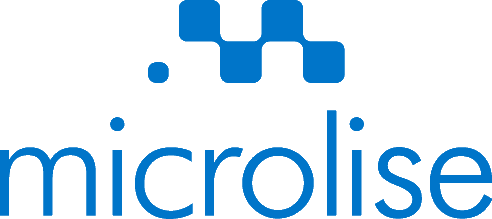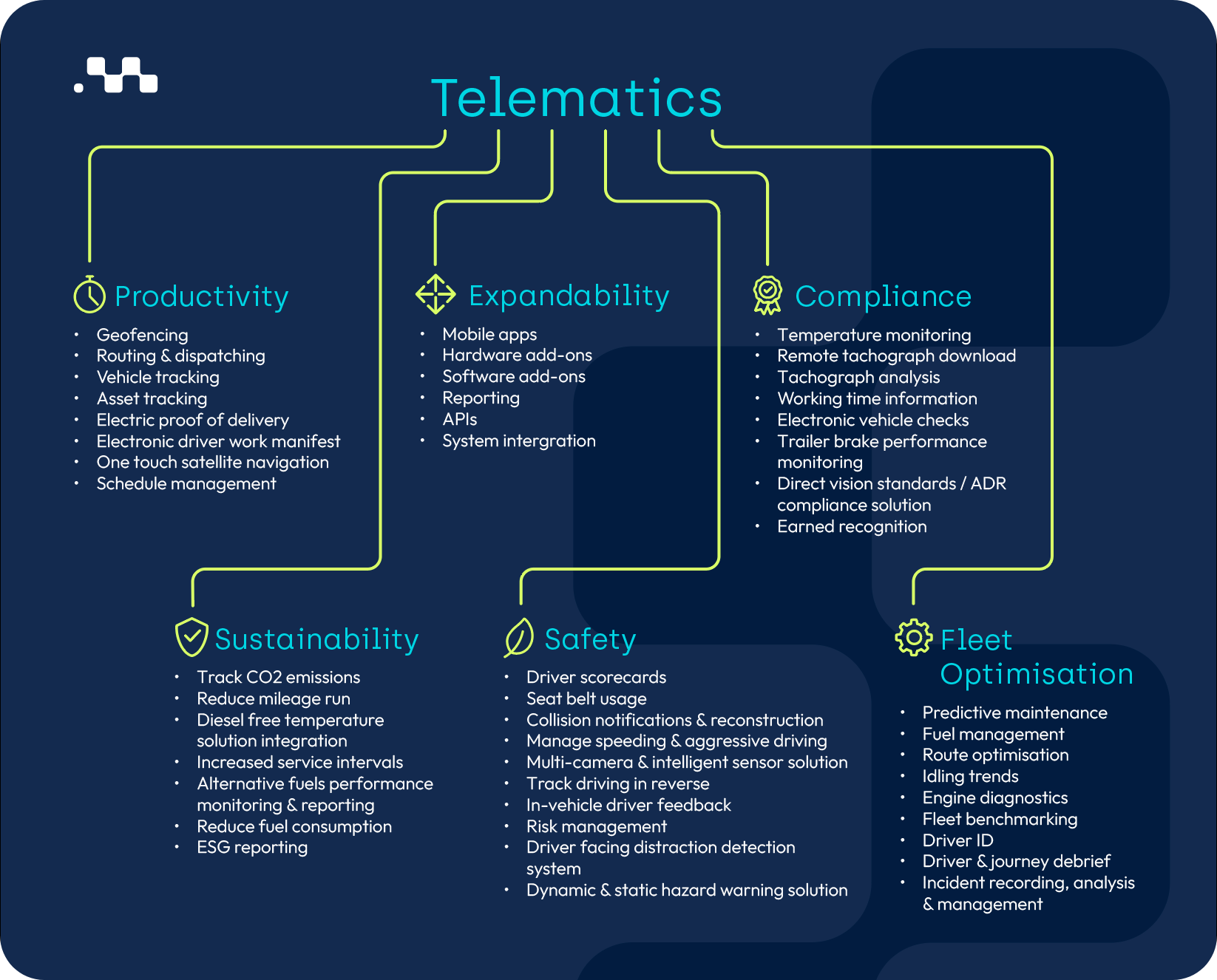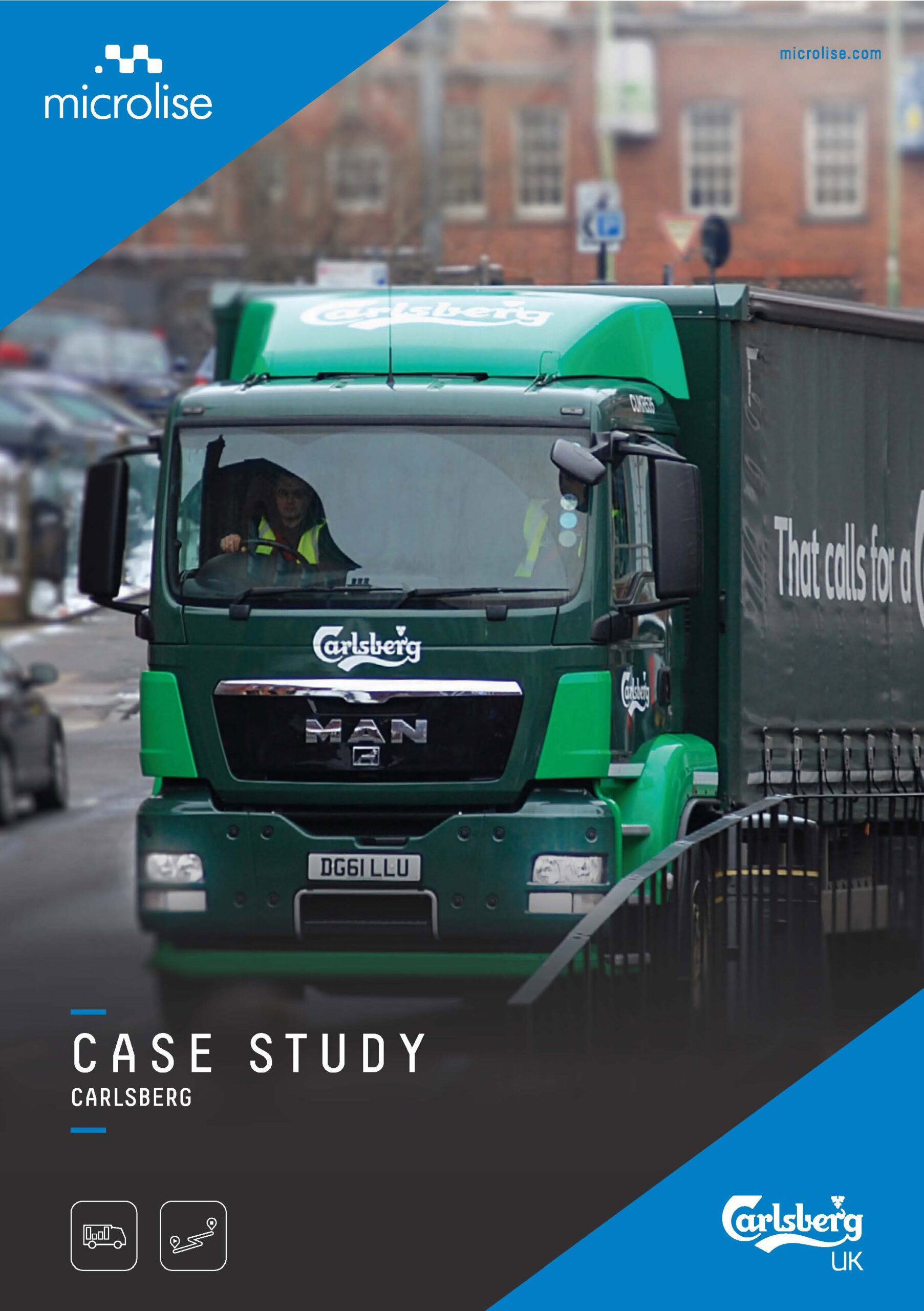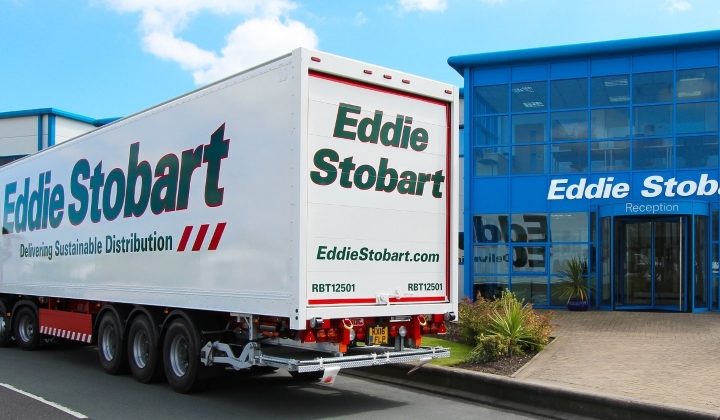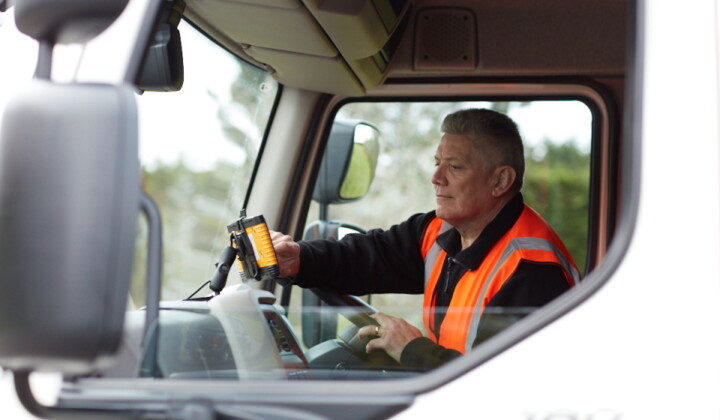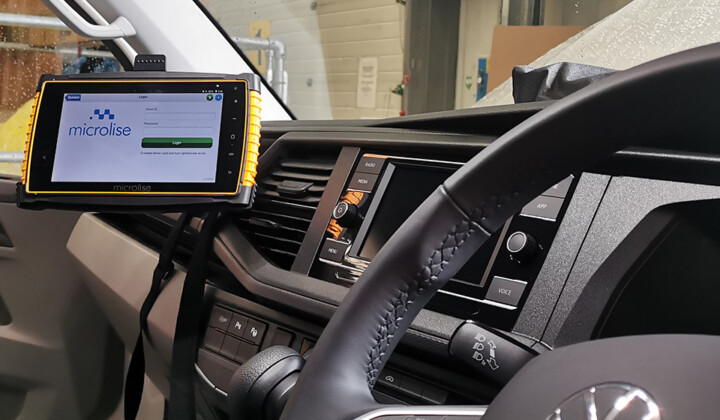Imagine if your vehicle could talk, telling you exactly where it is, how fast it's going, and even if something is wrong with it. That's telematics for you!
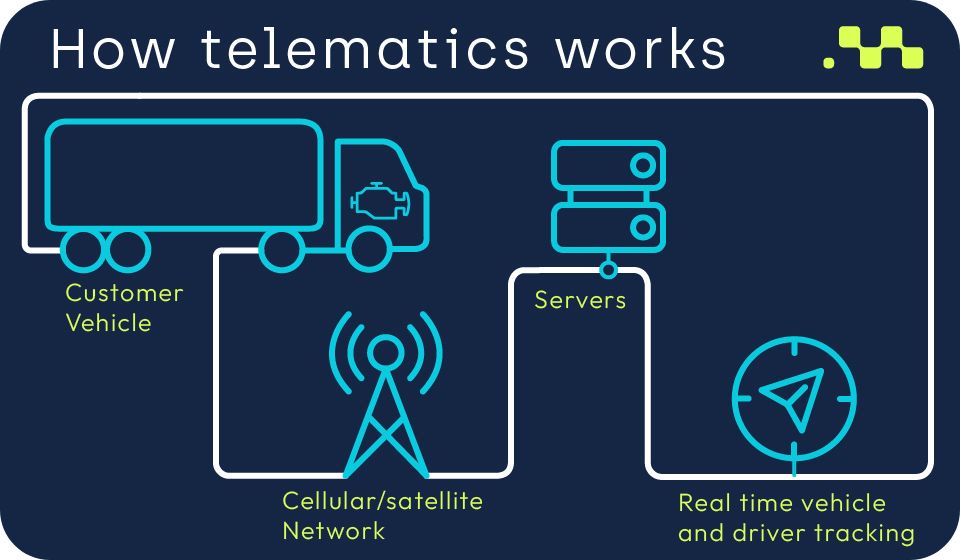
What is Telematics?
Telematics is a smart technology blend that lets vehicles communicate data over distances. Born from a mix of telecommunications and informatics, telematics has been around since the 1960s but has seriously taken off with advancements in GPS and internet technology.
At its heart, a telematics system is like the vehicle’s smartphone. It uses GPS and specialised onboard diagnostics to collect and share data about the vehicle’s condition and how it’s being driven. Telematics is crucial for managing fleets of vehicles efficiently, ensuring they are safe, and running smoothly.
Telematics Devices: The Vehicle's Voice
The telematics device is your vehicle’s way of speaking to you. Plugged into the vehicle, it captures important information — where it is, how it’s behaving, and even its health status — and then sends this data over a network to be analysed.
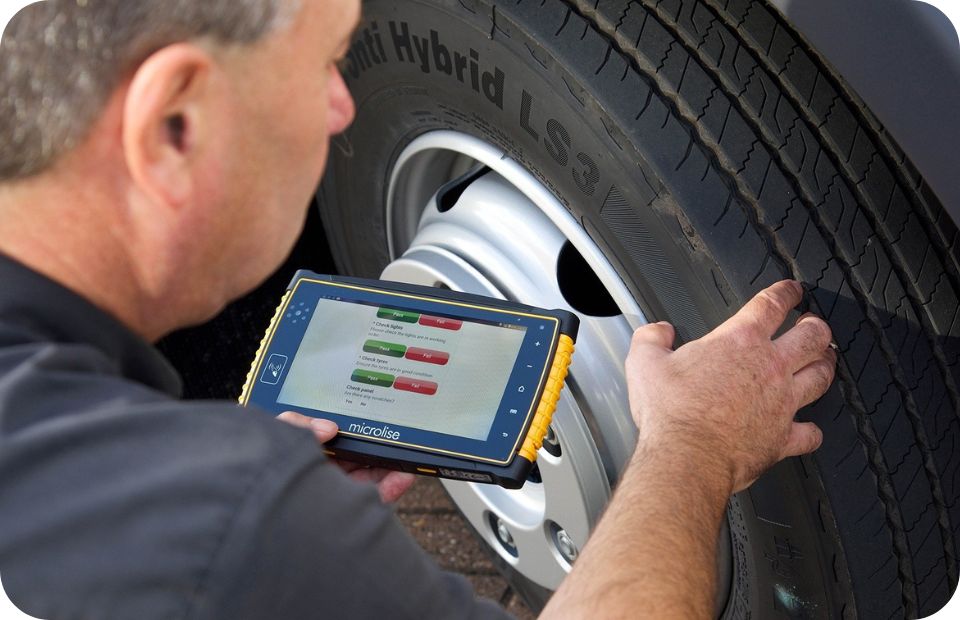
Here’s the process in a nutshell: The telematics device collects data and sends it over a cellular network to a server, where software processes this info. You get to see all these insights through an app or a website, making it easier to keep tabs on your vehicle or fleet.
Telematics has come a long way, from its conceptual beginnings to becoming a key player in the digital revolution of transportation, thanks to the boom in cellular and internet technologies.
Who Can Use Telematics?
While it began with commercial vehicles, telematics isn’t limited to them. Nowadays, it’s useful for personal cars, trucks, and even heavy machinery, offering a wide range of benefits like safety enhancements, cost savings, and efficiency improvements.
Personal Vehicle Owners
For those of us driving personal cars, telematics offers a treasure trove of benefits. Imagine having a virtual mechanic onboard, continuously monitoring your vehicle’s health, alerting you to potential issues before they become serious. Or consider the peace of mind that comes from enhanced security features like real-time tracking in case of theft, and automatic emergency calls if you’re involved in an accident. Plus, with detailed driving data at your fingertips, you can even improve your driving habits to save on fuel and reduce wear and tear on your vehicle.
Commercial Fleets
This is where telematics truly shines. For operators of commercial fleets, telematics is a game-changer, whether they’re delivery vans, taxis, or long-haul trucks. It’s not just about tracking where vehicles are; it’s about optimising routes to save time and fuel, monitoring driving habits for safety and efficiency, and scheduling maintenance to prevent breakdowns. This leads to significant cost savings, improved safety records, and better customer service through more reliable delivery times.
Trucking and Logistics
In the transport and logistics sector, telematics is critical for managing logistics operations, ensuring compliance with regulations such as driving hours, and keeping cargo safe. Real-time fleet tracking and alerts can help prevent theft, while temperature monitoring in refrigerated vehicles ensures goods arrive in perfect condition.
Public Transport Systems
Buses and other public transport vehicles benefit hugely from telematics. Transit authorities can use the data to optimise routes and schedules, reduce congestion, and improve passenger experience by providing real-time updates on vehicle locations and arrival times.
Construction and Heavy Machinery
In the world of construction, telematics can track the location and usage of heavy machinery like excavators, bulldozers, and cranes. This helps in scheduling maintenance, preventing theft, and ensuring that equipment is used efficiently, reducing idle times and saving fuel.
Emergency Services
For emergency service vehicles like ambulances, fire trucks, and police cars, telematics can literally be a lifesaver. It ensures the fastest response times by providing the best routes in real-time, monitoring vehicle conditions to avoid breakdowns, and improving the coordination of multi-vehicle responses.
Open Platform Telematics: Customisable and Flexible
Open platform telematics systems are versatile, letting businesses tailor the technology to their specific needs by integrating various apps and tools, ensuring the system grows with the business.
One of the most significant benefits of open platform telematics is the ability to customise the system to meet the specific needs of a business. Unlike closed systems, which offer a one-size-fits-all solution, open platforms allow businesses to pick and choose features, integrate third-party applications, and even develop custom functionalities. This means whether a business specialises in long-haul transport, ‘last-mile’ fast food deliveries, or operates a fleet of service vehicles, the telematics system can be tailored to address its unique challenges and objectives.
Integration with Existing Business Tools
Open platform telematics systems shine when it comes to integration capabilities. They can seamlessly connect with a wide range of business tools and systems, such as Enterprise Resource Planning (ERP) software, Customer Relationship Management (CRM) systems, and logistics and supply chain management platforms. This integration ensures that telematics data doesn’t stay siloed but instead enriches other business operations, offering insights that can lead to improved customer service, more efficient operations, and better decision-making.
Scalability: Growing with Your Business
As businesses evolve, their needs change. Open platform telematics systems are designed with scalability in mind, ensuring that as a business grows, its telematics solution can grow with it. Adding new vehicles to the fleet, expanding into new geographic areas, or even diversifying operations can be easily managed within the system, without the need for a complete overhaul or replacement.
Data Ownership and Control
With open platform systems, businesses typically have more control over their data. They can decide how to use it, with whom to share it, and how to analyse it for insights. This autonomy is crucial for companies that consider telematics data a valuable asset to improve performance, and are keen on using it to drive strategic decisions, improve operational efficiencies, or enhance customer experiences.
Enhanced Security Features
Open platforms are developed with a focus on security, offering robust features to protect sensitive data. Since these systems are frequently updated and supported by a community of developers, they can quickly respond to new security threats and vulnerabilities, ensuring that business and vehicle data remains safe.
Cost-Effective and Efficient
By allowing businesses to select only the features and integrations they need, open platform telematics can be a more cost-effective solution. Businesses can avoid paying for unnecessary functionalities, and enjoy the flexibility to invest in specific areas that offer the greatest return on investment. Additionally, integration with existing systems can lead to further efficiencies and cost savings by streamlining processes and reducing manual work.
Core Telematics Benefits
The benefits are many: safer roads, lower fuel costs, less time spent on the road, easier compliance with laws, and insights into driving habits for better training and safety programs…
Enhanced Road Safety
Telematics plays a crucial role in improving road safety, offering drivers and fleet managers real-time insights into driving behaviour. By monitoring speed, harsh braking, rapid acceleration, and harsh cornering, telematics systems can identify risky driving behaviours that contribute to accidents. This data is instrumental in developing targeted safety training and intervention programs, leading to a safer driving environment for everyone on the road.
Reduced Fuel Costs
Fuel efficiency is a significant concern for fleet operators. Telematics technology addresses this by monitoring fleet vehicle performance and driver behaviours that affect fuel consumption, such as idling, speeding, and inefficient routing. By analysing this data, telematics can offer suggestions for improvement, such as more fuel-efficient routes or driver training to adopt more fuel-saving driving techniques. The result is a noticeable reduction in fuel expenses, contributing to both economic and environmental benefits.
“We’re now about 6% better than we were, in terms of fuel consumption, before the start of the programme.”
Less Time Spent on the Road
Route optimisation is another standout feature of telematics, ensuring that drivers spend less time on the road. By analysing traffic patterns, weather conditions, and roadworks in real-time, telematics systems can suggest the most efficient routes to drivers, avoiding delays and reducing the time vehicles spend in transit. This not only improves punctuality and service quality but also reduces vehicle wear and tear and lowers fuel consumption.
Easier Compliance with Laws
For commercial fleet operators, complying with regulatory requirements can be challenging. Telematics software simplifies fleet compliance by automatically recording driving hours, rest periods, and other required data, making it easy to demonstrate compliance with transport laws. This reduces the administrative burden on drivers and fleet managers and helps avoid costly penalties for non-compliance.
Beyond these core advantages, telematics also offers benefits, including:

1. Improved Vehicle Maintenance
Predictive maintenance alerts can prevent costly breakdowns by notifying managers when a vehicle requires servicing, based on real-time diagnostics.

2. Theft Recovery
GPS tracking capabilities make it possible to recover stolen vehicles quickly, minimising losses.

3. Lower Insurance Premiums
Many insurance companies offer discounts for vehicles equipped with telematics devices, recognising the reduced risk of accidents and theft.
The Road Ahead for Telematics
The journey of telematics is far from over. As we advance into the future, the intersection of telematics with emerging technologies promises to bring about a new era of vehicle intelligence, safety, and efficiency. The roadmap for telematics is dotted with innovations that could redefine our driving experiences, traffic management systems, and the very fabric of vehicle operation. Future advancements include:
Advanced Predictive Maintenance
The future of telematics will see a significant leap in predictive maintenance capabilities. By harnessing the power of Artificial Intelligence (AI) and Machine Learning (ML), telematics systems will not only alert fleet managers about potential issues before they become problematic but will also predict the optimal time for maintenance based on real-world data, usage patterns, and manufacturer insights. This means less downtime, reduced maintenance costs, and longer vehicle lifespans.
Seamless Traffic Management
As our cities become more congested, the need for smarter traffic management becomes paramount. Telematics will play a pivotal role in this, offering dynamic routing based on real-time traffic conditions, accidents, and road works. Furthermore, integrating telematics data with smart city infrastructures can enhance traffic flow, reduce congestion, and minimise emissions, creating more liveable urban environments.
The Path to Autonomous Vehicles
Telematics is a critical stepping stone toward the development and adoption of self-driving vehicles. By continuously collecting and analysing vast amounts of data on driving conditions, vehicle performance, and driver behaviour, telematics provides the insights needed to refine autonomous driving algorithms. In the future, telematics will facilitate vehicle-to-vehicle (V2V) and vehicle-to-infrastructure (V2I) communications, essential components for the safe and efficient operation of autonomous vehicles in transport and logistics.
Enhanced Driver Assistance Systems
Driver assistance systems are set to become more sophisticated with the evolution of telematics. Future systems will not only provide real-time assistance for drivers but will also learn from individual driving patterns to offer personalized suggestions for safety and efficiency. For instance, suggesting the best times to travel to avoid traffic, reminding drivers of regular breaks to combat fatigue, and even adjusting vehicle settings for optimal performance under varying conditions.
Integration with Electric Vehicles (EVs) and the Charging Infrastructure
As the adoption of Electric Vehicles (EVs) accelerates, telematics will play a crucial role in managing EV fleets, monitoring battery health and performance, and optimising charging schedules based on usage patterns and electricity rates. Additionally, telematics can help drivers locate available charging stations in real-time, alleviating one of the primary concerns associated with EV ownership.
The road ahead for telematics is paved with exciting possibilities, each promising to enhance vehicle safety, efficiency, and connectivity. As telematics technology continues to evolve, it will not only redefine our relationship with vehicles but also play a critical role in shaping the future of transportation, making it smarter, safer, and more sustainable.
Looking for Telematics Solutions?
If you’re thinking about getting telematics for your vehicles, consider software solutions that offer comprehensive, easy-to-use tools tailored to fit your priorities.
To speak to a member of the Microlise team and start your telematics journey, click here.
